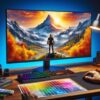Curved Comfort: Immersive Gameplay with Curved Gaming Monitors
In the realm of gaming monitors, curved displays have emerged as a popular choice for gamers seeking an immersive and engaging experience. These monitors offer a wraparound viewing experience that enhances peripheral vision, depth perception, and overall immersion in games. In this guide, we’ll explore the benefits of curved gaming monitors, their impact on gameplay, and considerations for selecting the perfect curved display to elevate your gaming setup.

Understanding Curved Gaming Monitors
The Curved Display Experience:
Curved gaming monitors feature a gentle curvature that mimics the natural curvature of the human eye, creating a more immersive and comfortable viewing experience. The curvature of the display helps reduce distortion and maintains consistent viewing distances across the entire screen, allowing gamers to maintain focus and engagement without straining their eyes or neck.
Enhanced Peripheral Vision:
One of the key benefits of curved gaming monitors is their ability to enhance peripheral vision. The curved shape of the display wraps around the viewer’s field of view, providing a wider and more encompassing view of the game world. This enhanced peripheral vision can be particularly beneficial in immersive and action-packed games, where being aware of your surroundings is crucial for success.
Benefits of Curved Gaming Monitors
Increased Immersion:
Curved gaming monitors offer increased immersion by enveloping the viewer in the game world and creating a sense of depth and presence. The curved shape of the display draws the viewer into the center of the action, making them feel more connected to the game environment and characters. This heightened sense of immersion can enhance the overall gaming experience and make gameplay more engaging and enjoyable.
Reduced Eye Strain:
The gentle curvature of curved gaming monitors helps reduce eye strain by maintaining a consistent viewing distance and reducing the need for eye movement. Unlike flat monitors, which can cause visual distortion and discomfort at the edges of the screen, curved displays provide a more natural and comfortable viewing experience, allowing gamers to play for longer periods without experiencing fatigue or discomfort.
Considerations for Selecting a Curved Gaming Monitor
Curvature Radius and Size:
When selecting a curved gaming monitor, consider factors such as curvature radius and screen size. The curvature radius refers to the degree of curvature of the display, with smaller curvature radii providing a more pronounced curve and greater immersion. Screen size is also important, as larger monitors may require a wider curvature radius to maintain optimal viewing angles and distances.
Panel Technology and Refresh Rate:
Consider the panel technology and refresh rate of the curved gaming monitor to ensure optimal performance and visual quality. Common panel technologies include Twisted Nematic (TN), In-Plane Switching (IPS), and Vertical Alignment (VA), each with its own strengths and weaknesses. Additionally, look for monitors with high refresh rates, such as 144Hz or 240Hz, to minimize motion blur and ensure smooth gameplay.
Gaming Experience with Curved Monitors
Enhanced Depth Perception:
Curved gaming monitors enhance depth perception by creating a more immersive and three-dimensional viewing experience. The curvature of the display helps differentiate between foreground and background elements, making it easier to judge distances and spatial relationships in games. This enhanced depth perception can be particularly beneficial in games with open worlds, complex environments, and dynamic lighting effects.
Improved Focus and Engagement:
The wraparound design of curved gaming monitors helps improve focus and engagement by reducing distractions and maintaining attention on the central area of the screen. Unlike flat monitors, which may cause visual distortion and distractions at the edges of the screen, curved displays provide a more uniform and cohesive viewing experience, allowing gamers to stay focused on the action without losing immersion.
Multi-Monitor Setups and Curved Displays
Creating Seamless Multi-Monitor Setups:
Curved gaming monitors are well-suited for multi-monitor setups, as their curved shape helps create a more seamless and cohesive viewing experience across multiple displays. When configuring a multi-monitor setup with curved displays, ensure proper alignment and curvature matching to minimize visual discontinuities and maintain immersion. Consider factors such as bezel width, viewing angles, and curvature radius when selecting monitors for a multi-monitor gaming setup.
Expanding Field of View:
Multi-monitor setups with curved displays can significantly expand the field of view and enhance immersion in games. By combining multiple curved monitors, gamers can create a panoramic viewing experience that wraps around them, providing a wider and more encompassing view of the game world. This expanded field of view can be particularly beneficial in simulation and racing games, where being aware of your surroundings is essential for success.


